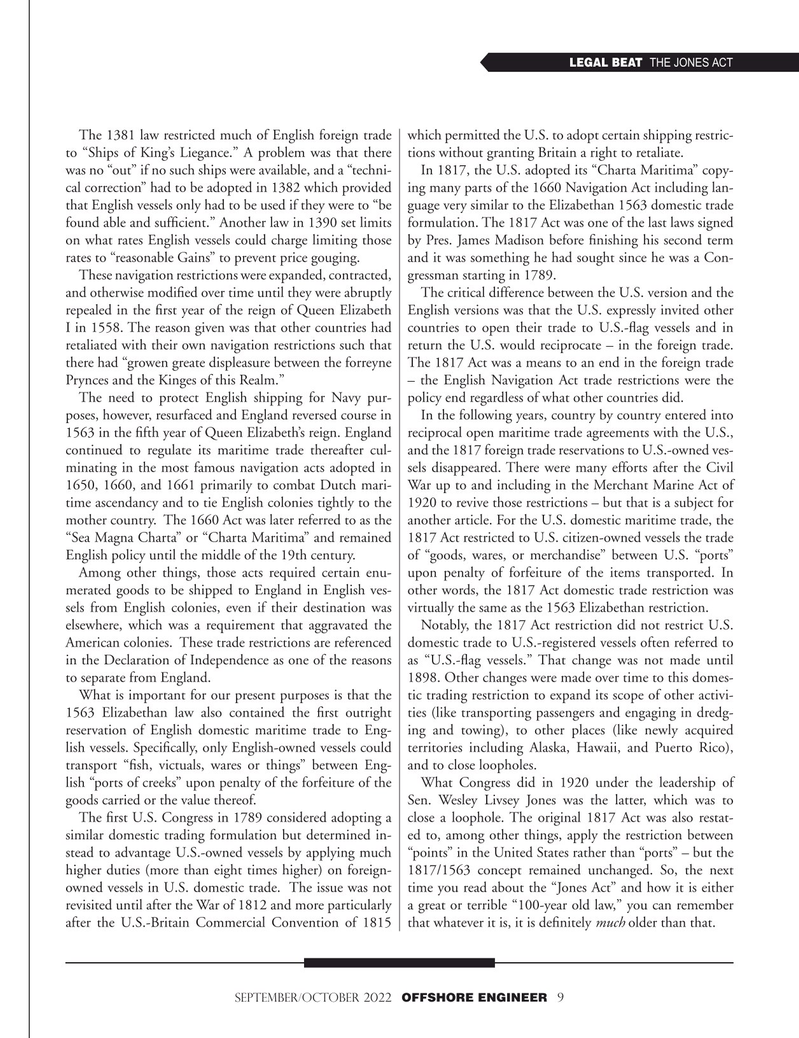
Page 9: of Offshore Engineer Magazine (Sep/Oct 2022)
Read this page in Pdf, Flash or Html5 edition of Sep/Oct 2022 Offshore Engineer Magazine
LEGAL BEAT THE JONES ACT
The 1381 law restricted much of English foreign trade which permitted the U.S. to adopt certain shipping restric- to “Ships of King’s Liegance.” A problem was that there tions without granting Britain a right to retaliate.
was no “out” if no such ships were available, and a “techni- In 1817, the U.S. adopted its “Charta Maritima” copy- cal correction” had to be adopted in 1382 which provided ing many parts of the 1660 Navigation Act including lan- that English vessels only had to be used if they were to “be guage very similar to the Elizabethan 1563 domestic trade found able and suffcient.” Another law in 1390 set limits formulation. The 1817 Act was one of the last laws signed on what rates English vessels could charge limiting those by Pres. James Madison before fnishing his second term rates to “reasonable Gains” to prevent price gouging. and it was something he had sought since he was a Con-
These navigation restrictions were expanded, contracted, gressman starting in 1789.
and otherwise modifed over time until they were abruptly The critical difference between the U.S. version and the repealed in the frst year of the reign of Queen Elizabeth English versions was that the U.S. expressly invited other
I in 1558. The reason given was that other countries had countries to open their trade to U.S.-fag vessels and in retaliated with their own navigation restrictions such that return the U.S. would reciprocate – in the foreign trade. there had “growen greate displeasure between the forreyne The 1817 Act was a means to an end in the foreign trade
Prynces and the Kinges of this Realm.” – the English Navigation Act trade restrictions were the
The need to protect English shipping for Navy pur- policy end regardless of what other countries did. poses, however, resurfaced and England reversed course in In the following years, country by country entered into 1563 in the ffth year of Queen Elizabeth’s reign. England reciprocal open maritime trade agreements with the U.S., continued to regulate its maritime trade thereafter cul- and the 1817 foreign trade reservations to U.S.-owned ves- minating in the most famous navigation acts adopted in sels disappeared. There were many efforts after the Civil 1650, 1660, and 1661 primarily to combat Dutch mari- War up to and including in the Merchant Marine Act of time ascendancy and to tie English colonies tightly to the 1920 to revive those restrictions – but that is a subject for mother country. The 1660 Act was later referred to as the another article. For the U.S. domestic maritime trade, the “Sea Magna Charta” or “Charta Maritima” and remained 1817 Act restricted to U.S. citizen-owned vessels the trade
English policy until the middle of the 19th century. of “goods, wares, or merchandise” between U.S. “ports”
Among other things, those acts required certain enu- upon penalty of forfeiture of the items transported. In merated goods to be shipped to England in English ves- other words, the 1817 Act domestic trade restriction was sels from English colonies, even if their destination was virtually the same as the 1563 Elizabethan restriction.
elsewhere, which was a requirement that aggravated the Notably, the 1817 Act restriction did not restrict U.S.
American colonies. These trade restrictions are referenced domestic trade to U.S.-registered vessels often referred to in the Declaration of Independence as one of the reasons as “U.S.-fag vessels.” That change was not made until to separate from England. 1898. Other changes were made over time to this domes-
What is important for our present purposes is that the tic trading restriction to expand its scope of other activi- 1563 Elizabethan law also contained the frst outright ties (like transporting passengers and engaging in dredg- reservation of English domestic maritime trade to Eng- ing and towing), to other places (like newly acquired lish vessels. Specifcally, only English-owned vessels could territories including Alaska, Hawaii, and Puerto Rico), transport “fsh, victuals, wares or things” between Eng- and to close loopholes. lish “ports of creeks” upon penalty of the forfeiture of the What Congress did in 1920 under the leadership of goods carried or the value thereof. Sen. Wesley Livsey Jones was the latter, which was to
The frst U.S. Congress in 1789 considered adopting a close a loophole. The original 1817 Act was also restat- similar domestic trading formulation but determined in- ed to, among other things, apply the restriction between stead to advantage U.S.-owned vessels by applying much “points” in the United States rather than “ports” – but the higher duties (more than eight times higher) on foreign- 1817/1563 concept remained unchanged. So, the next owned vessels in U.S. domestic trade. The issue was not time you read about the “Jones Act” and how it is either revisited until after the War of 1812 and more particularly a great or terrible “100-year old law,” you can remember after the U.S.-Britain Commercial Convention of 1815 that whatever it is, it is defnitely much older than that.
SEPTEMBER/OCTOBER 2022 OFFSHORE ENGINEER 9

 8
8

 10
10